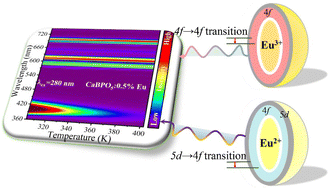Tetrahedrally coordinated rigid crystal structure enables partial self-reduction of mixed-valence europium for optical thermometric application†
Abstract
Mixed-valence europium-activated phosphors are receiving attention in many fields, such as lighting, anti-counterfeiting, optical recording, encryption, and temperature sensing. However, it remains difficult to construct mixed-valence europium-activated compounds due to the reductive and oxidative synthesis conditions required to obtain Eu2+ and Eu3+ ions, respectively. Herein, mixed-valence Eu2+/Eu3+ was realized in the CaBPO5 built by rigidly connected BO4 and PO4 tetrahedrons by partial Eu3+ → Eu2+ self-reduction in the air atmosphere. Commendably, the CaBPO5:Eu2+/Eu3+ phosphor exhibits excellent ratiometric temperature sensing performance with the maximum absolute and relative sensitivity being as high as 0.184 K−1 and 3.444% K−1 with good signal discriminability, due to the high and low, respectively, temperature-dependence of Eu2+ and Eu3+ emissions. The rapid dropping intensity of Eu2+ in CaBPO5 with increasing temperature was due to the small energy gap (∼0.48 eV) between the Eu2+-5d state and the conduction band. Our work not only provides a novel thermometer candidate but also enlightens researchers to a method of effectively designing new mixed-valence metal-ion activated luminescent thermometers via selective tetrahedrally coordinated rigid crystal structure.



 Please wait while we load your content...
Please wait while we load your content...